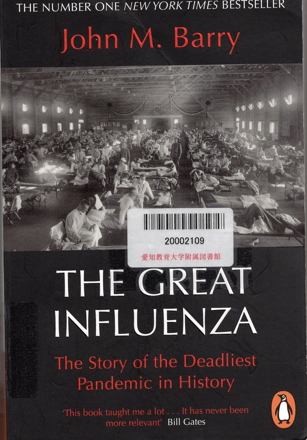A book I read during the second half of 2020 was:

John M. Barry, The Great Influenza: The Story of
the Deadliest Pandemic in History, Penguin 2004.
With the ‘Covid-19’ pandemic developing through 2020, I decided to
read this work written well before it, but meeting increasing
interest because of the so-called ‘Spanish Flu’ being considered
the closest parallel earlier event.
The writer actually focusses on two areas, the ‘Spanish Flu’
pandemic itself and the development of medicine and medical
education in the U.S. It was interesting to read how undervalued
medical education and research was until the late nineteenth
century. Endowments were far greater for subjects such as theology
and there were few checks on the quality of students who entered
medical colleges, not least because their faculty depended on
income directly from the number of students enrolled. However,
thanks to the drive of a succession of figures in the U.S. medical
world, both the quality of education and the pace and quality of
research improved. A central figure was William Henry Welch, who
took charge of numerous associations, acted as a mentor to younger
academics and was involved in the reorganization of existing
institutions and the establishment of new ones, not least Johns
Hopkins in Baltimore. J
As for the pandemic itself, it details how it developed, its
‘waves’ and how it spread geographically. The reader can see both
similarities and differences from the situation with Covid-19,
although probably more of the latter. Some were related to its
timing and relationship to the First World War. Spread, both
within the U.S. and to Europe was increased by the mobilization of
men as the U.S. entered the war. Military objectives overrode
public health considerations, as with the explosive spread through
Philadelphia, after the infamous holding of a parade to promote
the sale of ‘Liberty Bonds’ and suppression of news which might
sap morale led to the media underplaying the severity of that
pandemic. In contrast, the media in 2020 has arguably increased
anxiety with alarmist coverage, added to by the plethora of other
Internet ‘sources’ amplifying what has become known as ‘fake
news’. Obviously medical knowledge has greatly advanced in a
century, but at both times there was a similar urgency to find
both treatments and vaccines. In both cases, measures such as
closing schools and moving events outside were utilized. Spurious
treatments were championed. Interestingly, federal leadership was
lacking at both times in the U.S. and local administrations were
and have been left to deal with it. Interestingly, he is
dismissive of the (gauze) mask wearing that took place during the
’Spanish Flu’, as in: “The masks worn by millions were useless as
designed and could not prevent influenza” (358-359) and “The masks
were useless.” (375).
As for the actual effects, at both times, large ranges of severity
can be seen and mysterious symptoms can be seen. The earlier
pandemic showed a parallel with the enduring condition described
as ‘Long Covid’. As the writer indicates, “Months after
“recovering” from his illness, the poet Robert Frost wondered,
“What bones are they that rub together so unpleasantly in the
middle of you in extreme emancipation…? I don’t know whether or
not I’m strong enough to write a letter yet.” (p.392)
The parallel themes of the medical and medical education
developments and the course of the ‘Spanish Flu’ itself can lead
to some chronological challenges, as the time focussed on goes
back and forth and the work only has limited coverage of the
situation in other parts of the world. For example, reference to
its effects in Japan are limited to, “In Japan it attacked more
than one-third of the population.” (364) In addition, there is
some confusion in apparently somewhat contradictory statistics
concerning certain locations.
However, as the writer indicates, descriptions of the ‘Spanish
Flu’ pandemic are limited, particularly in fictional literature
from the period. Therefore, John M. Barry has provided readers
with a very valuable description of the two themes referred to
above, which have obviously become particularly relevant in this
‘Time of Corona’.
Find out about other
books which I have been reading.
